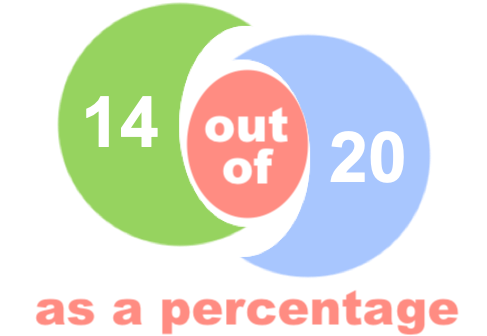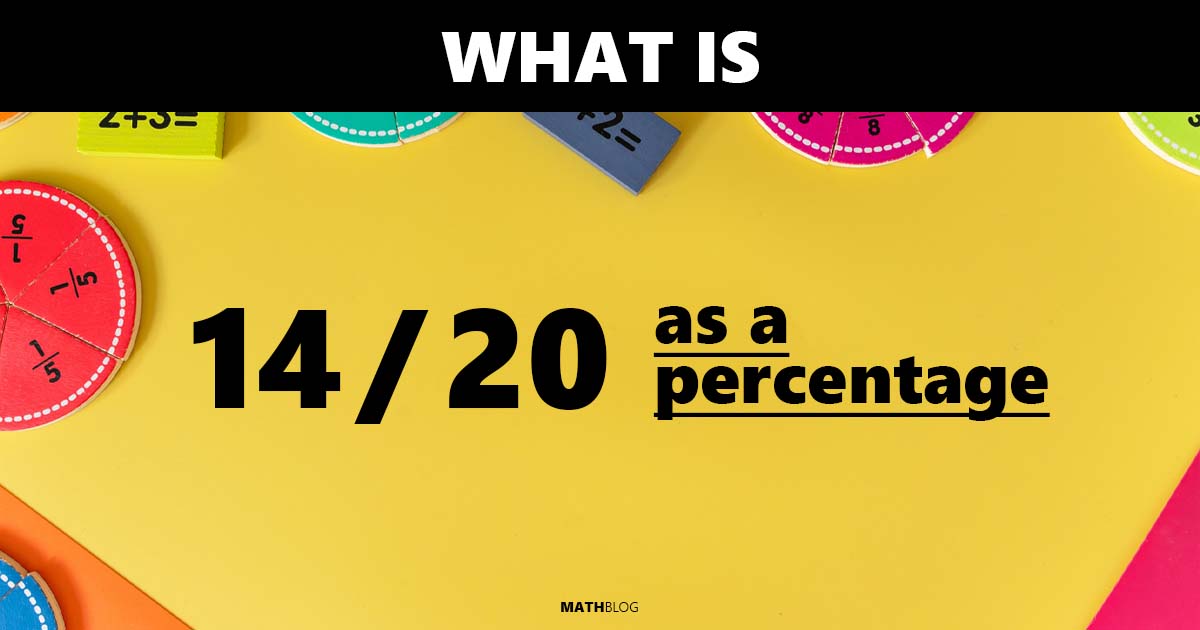A score of 14 out of 20 equals 70 percent. The conversion comes from dividing 14 by 20, which equals 0.7, and multiplying by 100 to express it as a percentage. While the mathematical value is clear, the interpretation of this score varies greatly depending on the grading system, academic policy, or cultural context.

Understanding the Fraction 14/20:
Basic Calculation:
-
Formula: (14 ÷ 20) × 100 = 70%
-
Equivalent fraction: 14/20 = 70/100 = 70%
-
Decimal form: 0.7
Meaning in Academic Grading:
A percentage of 70 represents an average performance level. It is often seen as satisfactory but not excellent. Its exact grade label, however, depends on country, institution, or examination board.
Letter Grade Equivalent of 14/20:
Many educational systems convert percentages to letter grades. Although variations exist, the following chart illustrates common mappings:
| Percentage | Letter Grade | Grade Point (4.0 Scale) | Interpretation |
|---|---|---|---|
| 90–100 | A | 4.0 | Excellent |
| 80–89 | B | 3.0–3.3 | Good |
| 70–79 | C | 2.0–2.3 | Average |
| 60–69 | D | 1.0–1.3 | Below Average |
| Below 60 | F | 0.0 | Failing |
Based on this table, 14/20 = 70% = C Grade ≈ 2.0 GPA.
14/20 in the French 20 Point Scale:
The French grading system uses a 0–20 scale with qualitative descriptors:
-
10–11.9: Passable (Satisfactory)
-
12–13.9: Assez Bien (Fairly Good)
-
14–15.9: Bien (Good)
-
16–20: Très Bien (Very Good)
In this system, 14/20 is officially “Bien”, considered a good performance. Unlike the US system where 70% is average, in France a 14 signifies strong achievement.
International Interpretations of 14/20:
Different countries use different grading standards. The perception of 70% varies globally:
-
United States: Often a C grade; considered satisfactory.
-
United Kingdom: In some higher education contexts, 70% = First-Class Honours.
-
India: 70% = Distinction, marking high academic success.
-
Germany: Roughly between 3.0–2.3, categorized as satisfactory to good.
-
Canada: 70% is often a B- or C+, depending on the province.
This diversity shows why global students must contextualize their scores based on the system in which they are evaluated.
Real Life Meaning of 14/20:
Academic Impact:
-
Minimum passing grade in many secondary schools.
-
May lower GPA if repeated across multiple courses.
-
Considered respectable in European and Asian grading systems.
Psychological Impact:
-
Students may perceive 70% as average or borderline.
-
Cultural expectations affect satisfaction with the score.
-
In France, students with 14/20 feel pride, while US students may see it as average.
Weighted Average Example of 14/20:
When grades are combined, weight affects the outcome.
Example:
-
Midterm (40% weight): 14/20 = 70% × 0.4 = 28
-
Final Exam (60% weight): 16/20 = 80% × 0.6 = 48
-
Total Score = 28 + 48 = 76%
This calculation shows that a single 14/20 may not damage overall results if balanced by higher scores.
Advantages and Limitations of 14/20:
Advantages:
-
Represents a passing performance.
-
In many systems, demonstrates good knowledge.
-
Provides a solid foundation for improvement.
Limitations:
-
Not competitive for scholarships.
-
May restrict entry to elite programs.
-
Perceived differently across countries.
Common Comparisons With 14/20:
Higher Scores:
-
15/20 = 75% (stronger performance)
-
16/20 = 80% (often considered good to very good)
-
18/20 = 90% (excellent performance)
Lower Scores:
-
13/20 = 65% (borderline passing in some schools)
-
12/20 = 60% (barely satisfactory)
-
10/20 = 50% (minimum pass in French system)
This comparative scale highlights the significant impact of one or two points on a 20-point scale.
Practical Uses of 14/20 Outside Education:
Workplace Metrics:
If 14 out of 20 employees meet targets, that equals 70% compliance.
Market Research:
If 14 out of 20 customers prefer a product, the preference rate is 70% adoption.
Quality Control:
If 14 out of 20 items pass inspection, the acceptance rate is 70%, which may or may not meet industry standards.
Key Facts About 14/20:
-
14/20 = 70% across all contexts.
-
Equivalent to a C grade in many systems.
-
Interpreted as “Bien” in French grading.
-
GPA equivalent ≈ 2.0 on 4.0 scale.
-
Indicates 6 points missed out of 20.
-
Can be average, good, or distinction depending on country.
Ways to Improve From 14/20 to Higher Scores:
-
Review incorrect answers to identify weak areas.
-
Practice more with similar question formats.
-
Focus on concepts with higher exam weightage.
-
Improve time management during assessments.
-
Use peer or tutor feedback for clarification.
Raising from 14/20 to 16/20 requires two additional correct answers, shifting from 70% to 80%.
FAQs About What is a 14 out of 20:
Q1: Is 14/20 always equal to 70%?
Yes. By mathematical definition, 14 divided by 20 equals 0.7 or 70%.
Q2: What is 14/20 on the GPA scale?
On a 4.0 scale, 14/20 (70%) ≈ 2.0 GPA, equivalent to a C grade.
Q3: How is 14/20 viewed in France?
It is considered “Bien,” meaning good, and reflects solid academic performance.
Q4: Is 14/20 a good grade for scholarships?
Not typically. Scholarships often require 80% or above.
Q5: What percentile rank is 14/20?
It depends on the group average. If most scores are below 70, it may rank higher.
Q6: Does 14/20 mean failure in any system?
Yes. In competitive exams requiring 75% or higher, 70% may be below passing standards.
Q7: How can students move from 14/20 to 18/20?
They need four additional correct answers out of 20, equivalent to raising the score by 20 percentage points.
Q8: Can 14/20 affect job opportunities?
Yes. Some employers use GPA cutoffs, and a 70% may restrict access to selective roles.
Learn More: Thank You for Noting: The Complete Guide to Correct Usage
How Many Grains in a Pound? Complete Conversion, History, and Uses
Conclusion:
What is a 14 out of 20 equals 70%, but its meaning depends on grading traditions, cultural contexts, and institutional policies. In some systems it is average, in others it is good, and in certain countries it is classified as distinction. Understanding its equivalence helps students, educators, and professionals interpret the score correctly in academic and non-academic scenarios.

